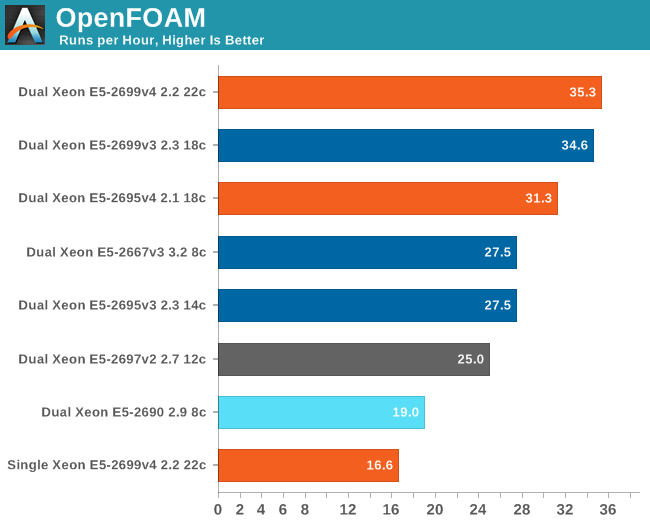The Intel Xeon E5 v4 Review: Testing Broadwell-EP With Demanding Server Workloads
by Johan De Gelas on March 31, 2016 12:30 PM EST- Posted in
- CPUs
- Intel
- Xeon
- Enterprise
- Enterprise CPUs
- Broadwell
HPC: Fluid Dynamics with OpenFOAM
Computational Fluid Dynamics is a very important part of the HPC world. Several readers told us that we should look into OpenFOAM, and my lab was able to work with the professionals of Actiflow. Actiflow specializes in combining aerodynamics and product design. Calculating aerodynamics involves the use of CFD software, and Actiflow uses OpenFOAM to accomplish this. To give you an idea what these skilled engineers can do, they worked with Ferrari to improve the underbody airflow of the Ferrari 599 and increase its downforce.
We were allowed to use one of their test cases as a benchmark, however we are not allowed to discuss the specific solver. All tests were done on OpenFOAM 2.2.1 and openmpi-1.6.3. The reason why we still run with OpenFOAM 2.2.1 is that our current test case does not work well with higher versions.
We also found AVX code inside OpenFoam 2.2.1, so we assume that this is one of the cases where AVX improves FP performance.

As this is AVX code, the clock speed of our Xeon processors can be lower than Intel's official specifications, and turbo boost speeds are also lower. Despite the fact that on Broadwell the only cores that reduce their clock when running AVX code are the AVX-active cores themseves (the others can continue at higher speeds), OpenFOAM does not run appreciably faster on the top of the line Xeon E5 v4 than it did on the E5 v3.
It is not as if OpenFOAM does not scale: 22% more cores delivers 13% higher performance (E5-2699v4 vs E5-2695v4). No, our first impression is that the new Xeon v4 needs to lower the clockspeed more than the old one. The official specifications tell us that both the Xeon E5-2699 v4 and v3 should run AVX code at up to 2.6 GHz with all cores enabled. The reality is however that Broadwell runs at a lower clock on average.










112 Comments
View All Comments
petar_b - Saturday, August 27, 2016 - link
Thanks Phil_Oracle, Brutalizer and Anand for this discussion. I have learned a lot from reading different opinions. I am working with IBM and Oracle software products, and from my small experience, Xeons are pathetic when compared to POWER or SPARC. To do same operation at home Xeon it takes 10x more time than what it takes the corporate server to do. I have double memory than corporate server and yet no help from it.someonesomewherelse - Thursday, September 1, 2016 - link
Btw how locked down are these Xeons and their motherboards in regards to overclocking? Assuming you could provide enough power and cooling could you reach a decent overclock? Obviously nobody is going to do that for mission crittical servers/workstations, but if I had too much money could I get a quad or octa core system with as much cores possible and at least try to overclock them?